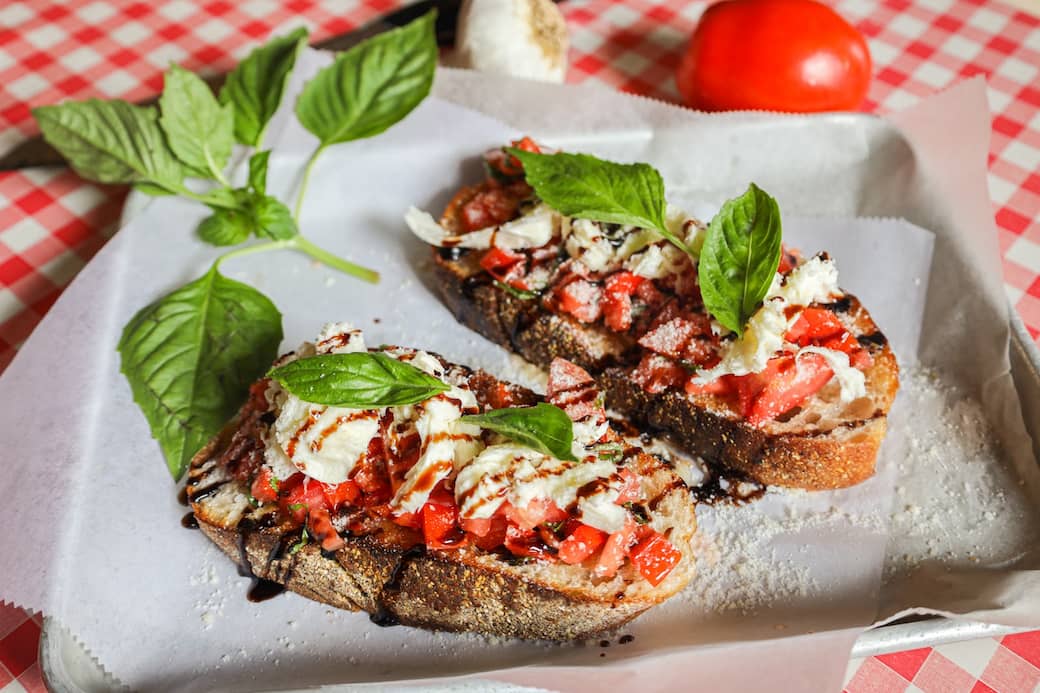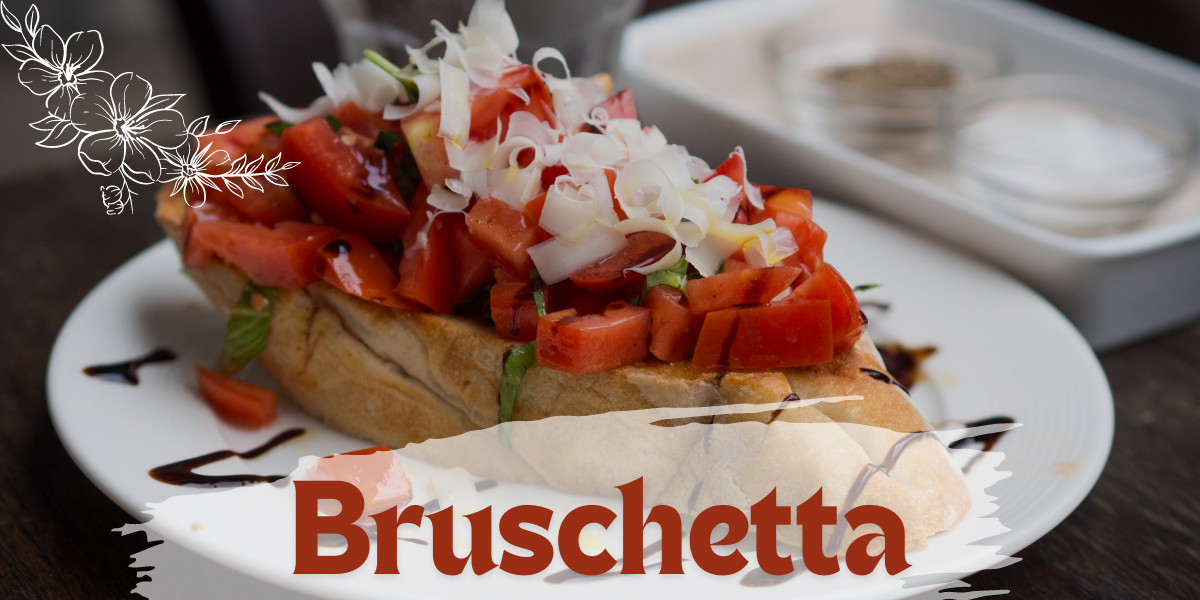Bruschetta, an elegantly simple meal with Italian roots, has won over the hearts and stomachs of foodies all around the globe. All you need is a mouthful of bruschetta to experience the flavors of the Mediterranean, thanks to its crispy toasted bread foundation and colorful, aromatic toppings. What makes this popular appetiser such a culinary masterwork? Let’s take a look at the craftsmanship that goes into making it.
Origins and Evolution:
One possible derivation of the English term “bruschetta” is the Italian verb “bruscare,” which means “to roast over coals.” Using leftover bread roasted over an open flame and topping it with simple ingredients like olive oil and garlic, bruschetta was traditionally a cuisine of the peasants. As time went on, it transformed into a multi-use appetiser that could feature anything from fresh tomatoes and basil to melted cheeses and cured meats.
The Bread Base: Crispy Canvas:
The foundation of bruschetta is always a bed of rustic Italian bread, such ciabatta or sourdough. Sliced bread is drizzled with olive oil, then roasted until golden, making a crispy base for tasty toppings. In addition to enhancing the bread’s flavor and adding texture, toasting makes it a strong base for the toppings.
:max_bytes(150000):strip_icc()/54165-balsamic-bruschetta-DDMFS-4x3-e2b55b5ca39b4c1783e524a2461634ea.jpg)
Toppings: Bursting with Flavor:
It is the toppings, which are ripe with taste and freshness, that take bruschetta to the next level. Garlic, extra virgin olive oil, pepper, diced tomatoes, and fresh basil make up the traditional topping. With the savoury olive oil and pungent garlic, this blend strikes a perfect balance between sweet, sour, and herbaceous flavors.
Nonetheless, bruschetta’s beauty is in the variety of ways it can be prepared. The list of possible toppings is endless: from burrata and savory prosciutto to acidic balsamic glaze and creamy avocado. Chefs and home cooks may enjoy a sensory adventure with each version, which allows them to play around with various ingredients and flavor profiles.
Presentation: A Feast for the Eyes:
The presentation of bruschetta is an art form, just like any other culinary work of art. The toasted bread is adorned with a variety of toppings, making for an aesthetically pleasing dish that tantalizes the taste buds even before they take a bite. A simple appetizer may be elevated to a visual feast with the help of vibrant colors, contrasting textures, and careful garnishes, laying the groundwork for an unforgettable meal.

Pairings: A Match Made in Culinary Heaven:
Not only can you top bruschetta with anything, but it also goes well with other foods. Bruschetta goes well with many different foods and drinks, making it a versatile appetizer, snack, or light dinner option. To bring out its vibrant tastes, try it with a dry white wine like Pinot Grigio or Sauvignon Blanc. As an alternative, try it with a bowl of robust soup or salad for a filling feast that honors the season’s wealth.
:max_bytes(150000):strip_icc()/how-to-make-bruschetta-2020459-hero-01-15950eb2b852461abc9cfbbf536382dd.jpg)
Recipe for Tomato and Basil Bruschetta:
Ingredients:
- 4-6 ripe tomatoes, diced
- 1/4 cup fresh basil leaves, chopped
- 2 cloves garlic, minced
- 2 tablespoons extra virgin olive oil
- 1 teaspoon balsamic vinegar (optional)
- Salt and freshly ground black pepper to taste
- 1 loaf Italian bread (ciabatta or baguette), sliced
- Olive oil for brushing
- Optional: Balsamic glaze for drizzling
- Optional: Shaved Parmesan cheese for garnish
Instructions:
- Preheat your oven to 400°F (200°C).
- In a bowl, combine the diced tomatoes, chopped basil, minced garlic, extra virgin olive oil, and balsamic vinegar (if using). Season with salt and pepper to taste. Toss gently to combine, then set aside to allow the flavors to meld.
- Slice the Italian bread into 1/2 inch thick slices. Place the bread slices on a baking sheet in a single layer.
- Brush both sides of the bread slices lightly with olive oil.
- Toast the bread slices in the preheated oven for about 5-7 minutes, or until they are golden brown and crispy. Keep an eye on them to prevent burning.
- Once the bread slices are toasted, remove them from the oven and let them cool for a minute or two.
- Spoon the tomato and basil mixture generously onto each toasted bread slice.
- If desired, drizzle a little balsamic glaze over the bruschetta for extra flavor and garnish with shaved Parmesan cheese.
- Serve the bruschetta immediately as an appetizer or snack, and enjoy!
Tips:
- For optimal results, choose tomatoes that are ripe and tasty. Tomatoes, whether Roma or cherry, are ideal.
- Depending on your taste, you can personalize the bruschetta toppings. To spice things up, you can add chopped olives, crumbled feta cheese, diced onions, or both.
- To toast the bread slices evenly, spread them out on a baking pan and don’t crowd them.
- Before adding the tomato mixture, massage the toasted bread pieces with a sliced garlic clove for added garlic taste.
Interesting facts about bruschetta:
Ancient Origins:
The original purpose of bruschetta was to use stale bread in ancient Rome. The peasants may restore the bread’s flavor by toaster-frying it and then smearing it with garlic.
Name Origins:
Where Do Names Come From? One possible origin of the English term “bruschetta” is the Italian verb “bruscare,” which means “to roast over coals.” Toasting bread over an open flame is the traditional method of producing bruschetta, and this depicts that.
Regional Variations:
There are innumerable regional variants of bruschetta throughout Italy, while the original recipe calls for tomatoes, basil, garlic, and olive oil. Cannellini beans and sage are typical toppings for bruschetta in Tuscany, whilst caponata and sundried tomatoes are common in Sicily.
Versatility:
The adaptability of bruschetta is one of its most attractive features. You can personalize the toppings to match your taste and the products that are in season, and it can be served as an appetizer, snack, or light dinner.
Healthy Option:
When prepared with nutritious components such as fresh tomatoes, olive oil, and whole grain bread, bruschetta may be a nutritious and healthful option. There are heart-healthy fats, antioxidant vitamins, and minerals in it.
Cultural Icon:
The Bruschetta sandwich is now a cultural symbol all across the globe, not only in Italy. It has become a mainstay in Italian restaurants and a favorite in many home kitchens and food communities throughout the world.
Social Tradition:
As a social tradition, bruschetta is frequently served during aperitivo hours in Italy. Sharing plates of wonderful food is a great way to bring people together, spark conversation, and foster friendship.
Pairing Possibilities:
Bruschetta goes nicely with many different kinds of drinks, such as cocktails, beer, and wine. Crisp white wines, such as Pinot Grigio or effervescent Prosecco, pair wonderfully with its acidity and brightness.
Quick and Easy:
Bruschetta is ideal for last-minute appetizers or spontaneous get-togethers because it is simple and takes little time to make. Quickly and easily whip up a delicious meal with only a few basic items.
Creative Expression:
There are countless ways to exhibit one’s creativity in the kitchen with bruschetta. Try it with various breads, toppings, and decorations to make it your own special version of this classic dish.

(FAQs) about bruschetta:
Q. What is bruschetta?
- Classic bruschetta toppings include garlic-rubbed toasted bread, diced tomatoes, basil, olive oil, and seasonings. This Italian dish is perfect for sharing.
Q. How do you pronounce bruschetta?
- Listen closely: the right way to pronounce it is “broo-SKEH-tah,” stressing the initial syllable.
Q. What type of bread is used for bruschetta?
- Ciabatta or baguette, two rustic Italian breads, are the traditional ingredients for bruschetta. To make a crunchy basis for the toppings, the bread is toasted and cut.
Q. Can I make bruschetta ahead of time?
- You should put the bruschetta together right before serving if you want the toast to stay crisp, but you may make the topping ahead of time and keep it in the fridge. For the most flavorful bruschetta, toast the bread slices right before serving and put everything together right before digging in.
Q. What are some common variations of bruschetta toppings?
- Diced tomatoes, basil, garlic, and olive oil are the traditional toppings, but there are many variants. Avocado and feta, prosciutto and arugula, roasted red peppers and goat cheese, and bruschetta with mozzarella and balsamic glaze are a few common choices.
Q. Is bruschetta served hot or cold?
- It is usual to serve bruschetta at room temperature. Toasted bread is hot, but toppings are often cold or room temperature so that they can really show off their tastes.
Q. Can I make bruschetta without garlic?
- Garlic is a classic addition to bruschetta, but feel free to leave it out if you’d rather not or are trying to stick to a strict diet. To make it milder, you may either use olive oil that already has garlic in it instead of rubbing the garlic into the toasted bread, or you can skip that step altogether.
Q. What are some tips for serving bruschetta?
- Spoon the topping mixture generously over each slice of toasted bread before arranging them on a dish to serve bruschetta. To enhance the flavor, you have the option to drizzle it with balsamic sauce or top it with grated Parmesan cheese. Quickly serve as a snack or appetizer.
Q. Is bruschetta vegetarian/vegan?
- By switching out the toppings, bruschetta may easily be made vegan or vegetarian. Some variants of bruschetta, such as avocado and tomato or roasted veggies, can be made vegan by leaving out the cheese or using a dairy alternative that is suitable for vegetarians. The basic tomato and basil bruschetta is already vegetarian.
Q. What beverages pair well with bruschetta?
- White wines (Pinot Grigio, Sauvignon Blanc, etc.), sparkling wines, beer, cocktails, and other alcoholic and non-alcoholic drinks go wonderfully with bruschetta. Because of its tang and sourness, bruschetta goes well with a wide variety of cocktails.
Conclusion: A Culinary Journey:
Finally, bruschetta exemplifies the skill and beauty of Italian cooking with its bite-sized portions of fresh, simple ingredients. From its modest beginnings to its contemporary takes, bruschetta’s irresistible allure has captivated diners throughout the globe. Bruschetta takes us on a gastronomic adventure that honors the simplicity of good food and the beauty of basic tomato and basil combinations as well as new culinary creations.
THANKS FOR READING
READ MORE :- The Keto Cauliflower Pizza Revolution: A Delightful New Way to Cook Delicious Food
